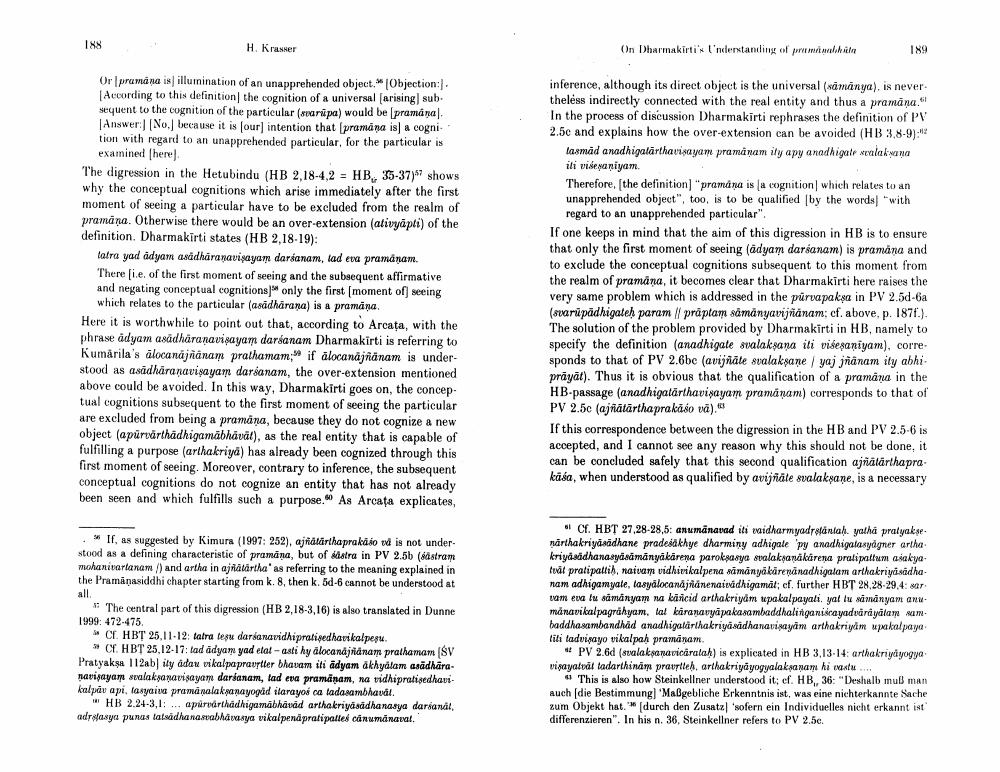Book Title: On Dharmakirtisunderstanding Of Pramanabhuta And His Definition Of Pramana Author(s): Helmut Krasser Publisher: Helmut Krasser View full book textPage 9
________________ 188 Hkrasser On Dharmakirtis inderstanding of the 189 Or pramana is illumination of an unapprehended object. Objection: According to this definition the cognition of a universal (arising sub sequent to the cognition of the particular (svarūpa) would be pramana) Answer: No. because it is (our) intention that pramana is a cogni tion with regard to an unapprehended particular, for the particular is examined (here The digression in the Hetubindu (HB 2.18-4,2 = HB, 35-37) shows why the conceptual cognitions which arise immediately after the first moment of seeing a particular have to be excluded from the realm of pramana. Otherwise there would be an over-extension (ativyapti) of the definition. Dharmakirti states (HB 2,18-19): latra yad adyam asidharanavisayam darśanam, tad era pramdam There [ie, of the first moment of seeing and the subsequent affirmative and negating conceptual cognitions only the first moment of seeing which relates to the particular (asadharana) is a pramana Here it is worthwhile to point out that, according to Arcata, with the phrase adyam asidharanavipayam darsanam Dharmakirti is referring to Kumarila's alocanajranam prathamam; if alocanajnanam is understood as asādharanavisayam darsanam, the over-extension mentioned above could be avoided. In this way, Dharmakirti goes on, the conceptual cognitions subsequent to the first moment of seeing the particular are excluded from being a pramana, because they do not cognize a new object (apürvarthadhigamabhaval), as the real entity that is capable of fulfilling a purpose (arthakriya) has already been cognized through this first moment of seeing. Moreover, contrary to inference, the subsequent conceptual cognitions do not cognize an entity that has not already been seen and which fulfills such a purpose. As Arcata explicates, inference, although its direct object is the universal (saminya), is never. theless indirectly connected with the real entity and thus a pramana. In the process of discussion Dharmakirti rephrases the definition of PV 2.50 and explains how the over-extension can be avoided (HB 3.8-9).** tasmad anadhigalarthavisayam pramanam ily apy anadhigale salakana ili widepaniyam. Therefore, the definition] "pramana is a cognition which relates to an unapprehended object", too, is to be qualified by the words with regard to an unapprehended particular" If one keeps in mind that the aim of this digression in HB is to ensure that only the first moment of seeing (adyam darsanam) is pramana and to exclude the conceptual cognitions subsequent to this moment from the realm of pramana, it becomes clear that Dharmakirti here raises the very same problem which is addressed in the purvapaksa in PV 2.5d-6a (svar pādhigateh param prāptam sámányavijnanam; cf. above, p. 1871.). The solution of the problem provided by Dharmakirti in HB, namely to specify the definition (anadhigate svalaksana ili višeşaniyam), corre sponds to that of PV 2.6be (avijñāte svalaksane / ya jnanam ity abhi prayat). Thus it is obvious that the qualification of a pramana in the HB-passage (anadhigatarthavisayam praminam) corresponds to that of PV 2.5c (jflatārthoprakdso vũ). If this correspondence between the digression in the HB and PV 2.5-6 is accepted, and I cannot see any reason why this should not be done, it can be concluded safely that this second qualification ajñatarthapra käsa, when understood as qualified by avijfáte svalakpaņe, is a necessary II, as suggested by Kimura (1997: 252), ajfiátarthaprakabo is not under stood as a defining characteristic of pramana, but of kistra in PV 2.5b (astram mahanivartanam /) and artha in ajralartha' as referring to the meaning explained in the Pramanasiddhi chapter starting from k. 8, then k. 60-6 cannot be understood at all The central part of this digression (HB 2,18-3,16) is also translated in Dunne 1999: 472-475. CE HBT 25.11.12: tatra tesu darsananidhipratifedhavkalper * CT. HBT 25.12-17: tad adyam yad etal-asti hy alocandjánam prathamam SV Pratyaksa 112ab) ily adau vikalpapravytter bhavam iti adyam akhyalam andhara. narimayam salaksanavisayam darsanam, tad era pramanam, na vidhipratisedhani kalau api, tasyair prom nalak onayogid ilarayoi ca tadasambhaval WHB 2.24-3.1: ... apurarthadhigamabhavad arthakriyasadhanasya daranál. adrasya punas tatsadhananabhavanya vikalpenápratipaltes can manaval "C HBT 27,28-28,5: arumānavad ili waidharmyadrolantah, yatha pratyakse. narthakriyaaddhane pradesákhye dharminy adhigale 'py anadhigatasyågner artha kriyaadhanasydaāmānyābārena parokrasya salaksanakarena pralipatum asakya tudi pratipattih, naivam vidhivikalpena simanya karena nadhigalam arthakriyasadha nam adhigam yale, tasyilocanajfianenaividhigamál; cf. further HBT 28.28-29.4: mar wameua tu samanyam wa karicid arthakriyam pakalpayali yallu samanyaman månavikalpagráhyam, tal baranavyāpakasambaddhalinganiscayadedrayalam um baddhasambandhad anadhigalarthakriyasadhanarimayim arthakriyim upakalpaya tili tadvigayo vikalpah pramānam. PV 2.6d (salaksanavicaralak) is explicated in HB 3,13-14: arthakriyayogya vipayatolladarthind proutten, arthakriyayogyalaksanam hitu.... This is also how Steinkellner understood it; cf. HB, 36: "Deshalb mullman Auch die Bestimmung] Maßgebliche Erkenntnis ist, was eine nichterkannte Sache zum Objekt hat, durch den Zusatz'sofern ein Individuelles nicht erkannt ist differenzieren". In his n. 36, Steinkellner refers to PV 2.50.Page Navigation
1 ... 7 8 9 10 11 12 13 14
